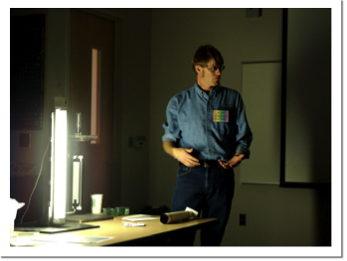



Omah Williams
McDonald Observatory Davis Mountains
N 30 68.084', W 103 01.502';
Elevation 6602.3’ (at HET)
Content:
Spectroscopes
 Spectroscopy is the science of collecting and observing light that has been separated into its component colors. White light may be separated into a multicolored band called the visible spectrum. The visible spectrum is apart of the visible region of the electromagnetic spectrum and includes the colors red, orange, yellow, blue, indigo and violet.
Spectroscopy is the science of collecting and observing light that has been separated into its component colors. White light may be separated into a multicolored band called the visible spectrum. The visible spectrum is apart of the visible region of the electromagnetic spectrum and includes the colors red, orange, yellow, blue, indigo and violet. When looking at objects, we are able to “see” them because the object reflects and/or absorbs certain wavelengths of visible light or transmits light. Spectroscopes are used to determine the spectra of emitted light by substances or objects. Simple spectroscopes consist primarily of a light source, a slit that allows a narrow entry for light, a darkened area, diffraction grating, and the eye (Figure 1).
 In the simple spectroscope featured in figures 2 and 3, light passes through a narrow slit and diffraction grating. The diffraction grating refracts the light into its component colors. If the slit is very narrow, the resulting spectra may have more intense color bands. We are able to see the spectra by looking through the diffraction grating into a dark area.
In the simple spectroscope featured in figures 2 and 3, light passes through a narrow slit and diffraction grating. The diffraction grating refracts the light into its component colors. If the slit is very narrow, the resulting spectra may have more intense color bands. We are able to see the spectra by looking through the diffraction grating into a dark area. 

Astronomers use spectroscopes to determine the chemical composition of stars. Atoms emit and absorb certain wavelengths of light. Stars are made of gases that undergo nuclear fusion. During nuclear fusion, light and heat are produced. Astronomers can determine the chemical composition of stars by studying the light they emit. All chemical elements have unique emission and absorption spectra. As emitted light from a star is observed and collected in a spectroscope, astronomers are able to identify the chemical components of the star by comparing the star’s spectra with known emission spectra of chemical elements.
A solid or high pressure gas makes a continuum spectrum, a continuous band of color at different wavelengths. An absorption spectrum occurs when a substance’s atoms absorb certain wavelengths of light. The resulting spectrum appears as though bands of color are missing. Emission spectra appear as specific intense bands of color. These intense bands are related to the substance’s ability to emit light at particular wavelengths. Emission spectra and absorption spectra of the same substance are opposites of one another. As previously mentioned, they may be used to identify unknown substances.
Telescopes
Astronomers collect and observe light through telescopes. There are two main types of telescopes, refracting and reflecting telescopes. While both types of telescopes produce an image that is upside down, refracting telescopes use lenses while reflecting telescopes use mirrors to focus light toward the observer.




References:
Burnie, D. (2000) Light. New York, NY: Dorling Kindersley Limited.
Daunt, S, and Yost, R. "Telescopes and Detectors." Astronomy 162: Stars, galaxies and cosmology. 2006. University of Tennessee. 26 June, 2006 <http://csep10.phys.utk.edu/astr162/lect/index.htmll>
Stott, C. (1999) New astronomer: The practical guide to the skills and techniques of
sky-watching. New York, NY: Dorling Kindersley Limited.
West Texas “Taking a Closer Look” Field Experience
(if available, please insert the tune “Fantastic Voyage” by Lakeside)
Reflection
Upon arriving in El Paso, we were given a short lecture on Moh’s Hardness Scale and the rock cycle. We also received several rock and mineral samples as examples of rocks in the rock cycle. All of that stuff seemed routine and a standard component of any good earth science workshop. It wasn’t until we got into the vans and the landscape became our actual classroom that things became a little more interesting.
Using the text, Roadside Geology of Texas, and a standard Texas map, we navigated from El Paso toward the Davis Mountains. While I had gone on several road trips as a child, I still did not know the magnitude of what was in store.
As we left El Paso the landscape seemed to open up. As the town drifted behind us in the distance, I began to think about where we were and where we were going. We were in “God’s” country. From the scenic road cuts to the colorful rocks the jutted out, everything around us confirmed my personal beliefs about religion. It became amazing (Figure 6). With so many colors and formations, each with an explanation, a story, it wasn’t hard to wonder how it was all created.
I rode in a van with Diane Brownlee, Director of Ellison Miles Geotechnology Institute. During the 3 – 4 hour ride she explained the layout of the land, directing our attention toward fault lines, slumps, the desert bowl and columnar jointing. She talked about the Laramide orogney, what the area probably looked like during Cenozoic times, and began to paint a picture of why we were seeing what we were seeing.
Was it hot? Yes. Did I listen all the time? No. Sometimes I couldn’t help but think about simpler times when road trips gave you the opportunity to look, stare, and wonder about the landscape, cars, and people you passed on your journey. However, it became hard to simply stare out of the window. No matter where you looked, the landscape was laid before you like a natural textbook that was always open, beckoning for you to “read” its pages (Figure 7). As questions would come to mind, the voice of Dr. Brownlee would answer the question. It was like being on tour with an expert tour guide that was on call.
At our break stop, I decided to buy corn-nuts, gummi bears, and beef jerky to truly make the experience a little more authentic. After all, a road trip is not official unless you eat junk food. Little did I know that this was not just any ordinary road trip, but the beginning of a fantastic voyage.
Upon our arrival at Indian lodge (Figure 8), we were greeted by friendly staff that indicated where we would be living for the next four days. Polished wooden floors with matching ceilings and quaint southwest Native American motif greeted us as we placed our luggage in the rooms. Warned to look under our beds for scorpions or spiders, we complied by looking throughout the room. To our disappointment, we didn’t find any.
The next day seemed to come quickly. We headed to Woodard Ranch for a rock hunt after an early morning breakfast. While I like rocks, I only thought of them as pretty and shiny pieces of history that were required study for the TEKS. I cannot recall ever being exposed to rocks in such a manner that would cause so much excitement.
With scratches on my legs, sweat on my brow, and a keenly trained eye, I waded through the thicket looking for “biscuits” of agate and other neat finds. I didn’t want to leave. I found all sorts of stuff. Pulling out my jeweler’s loupe or holding the object to the sun, I checked for bumps, transparency, and/or the presence of crystals (Figure 9). My appetite for rocks grew as did my appetite for lunch. Leaving the Woodard Ranch, we drove to the McDonald Observatory, atop one of the Davis Mountains, for lunch and the beginning of our astronomy lesson.
In one of the McDonald Observatory classrooms, we investigated magnifiers and cameras and built a simple refracting telescope. Each activity provided a powerful connection to what we would be experiencing and touring on the following day. While we were surrounded by huge telescopes, the lessons seemed too simple as compared to the scale of the telescope technology. In retrospect, the activities provided a great foundation for the core concepts needed to build each of the large telescopes at the McDonald observatory.
Overall, I must admit that the apex, the high-point, the crème de la crème of our trip was the stargazing party. Prior to the stargazing party we were presented with telescopes….TO KEEP!!!! I instantly thought about being able to show others everything we were learning. I wanted to coordinate a stargazing party. I wanted to make sure that others were given the opportunity to see PLANETS
and stars for themselves. While I have seen stars and planets in a textbook, through a telescope that you were not aloud to focus, or on the Internet, nothing was as special and as meaningful as being able to point the telescope, YOURSELF, to any object in the sky, peer through the view finder, and SEE MOONS, PLANETS AND STARS (Figure 7). It was absolutely amazing….and I could see for my very own eyes that God is real. For that, I am forever grateful.
Omah, has completed a great reflection covering her experience on the field trip as a whole. Click the above triangle to view her reflection.


Thursday, June 8, 2006








Fig 1
Fig 2
Fig 3
Fig 4
Fig 5






